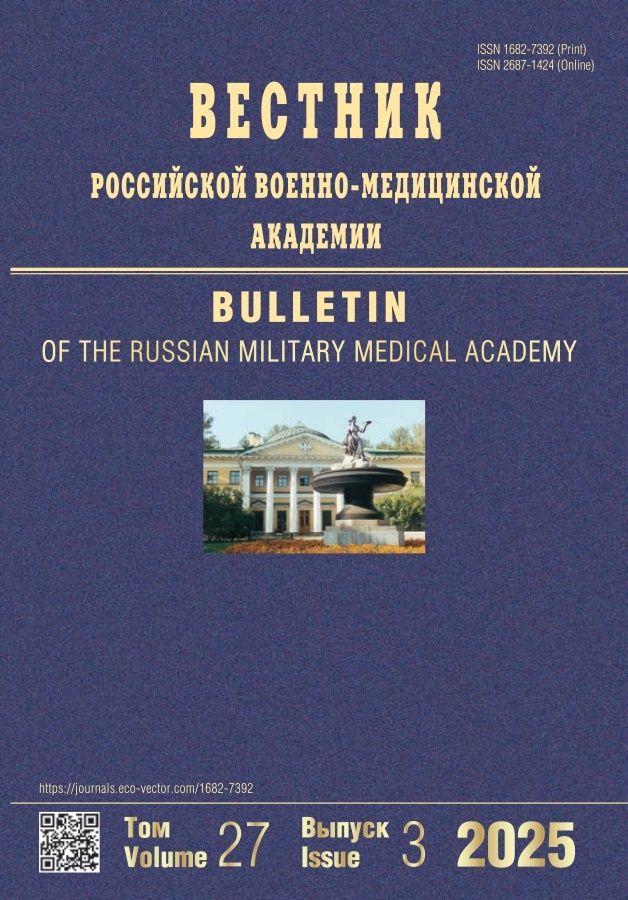Эндоскопическая задняя сепарационная пластика в лечении пациентов со срединными послеоперационными грыжами
- Авторы: Бурдаков В.А.1, Зверев А.А.1, Макаров С.А.2, Стрижелецкий В.В.2, Рутенбург Г.М.2, Матвеев Н.Л.3
-
Учреждения:
- Воскресенская районная больница № 2
- Городская больница Святого Великомученика Георгия
- Российский национальный исследовательский медицинский университет им. Н.И. Пирогова
- Выпуск: Том 22, № 3 (2020)
- Страницы: 82-87
- Раздел: Клинические исследования
- URL: https://journals.rcsi.science/1682-7392/article/view/50539
- DOI: https://doi.org/10.17816/brmma50539
- ID: 50539
Цитировать
Аннотация
Резюме. Вопросы реконструкции передней брюшной стенки у пациентов со срединными послеоперационными вентральными грыжами остаются актуальными на протяжении многих лет. Парадигма их лечения постепенно смещается в сторону функциональных минимально инвазивных реконструкций передней брюшной стенки. Рассматриваются показания к проведению и технические аспекты эндоскопической задней сепарационной пластики. Проанализированы операции у 70 пациентов в возрасте 61,2±10 лет со срединными послеоперационными вентральными грыжами, перенесшими эндоскопическую заднюю сепарацию брюшной стенки. Медиана наблюдения составила 14,2±8,2 мес., анестезиологический риск – 2,8±0,5. Средняя площадь грыжевого дефекта – 151,7±73,7 см2, площадь импланта – 832,9±243,3 см2. В раннем послеоперационном периоде осложнения наблюдались у 7 (10%) пациентов, из них у одного – ретромускулярная гематома, у четырех – инфекция ретромускулярного пространства и у двоих – тромбофлебит поверхностных вен. Поздние осложнения наблюдались у 6 (8,7%) пациентов – персистирующая серома (3) и хроническая боль (3). Рецидивов заболевания в указанный период не выявлено. Таким образом, использование эндоскопической сепарации брюшной стенки позволяет снизить риск местных осложнений по сравнению с аналогичной открытой операцией. При этом сохраняется низкий уровень рецидивов заболевания и удовлетворительное качество жизни. В целом из традиционного и эндоскопического доступов выполнено 70 (100%) вмешательств, из них в виде билатеральной операции – 14 (77,8%) и 32 (61,5%), унилатеральной операции – 4 (22,2%) и 20 (38,4%) соответственно. Из всех операций гибридным доступом выполнено 10 (14,3%) вмешательств: 3 (16,7%) и 7 (1,5%) традиционным и эндоскопическим доступами соответственно. Симультанные вмешательства имели место в 13 (18,6%) случаях, из них лапароскопическая холецистэктомия – в 7 (10%) случаях, эндоскопическая паховая герниопластика – в 6 (8,6%) случаях.
Полный текст
Открыть статью на сайте журналаОб авторах
В. А. Бурдаков
Воскресенская районная больница № 2
Email: n.l.matveev@gmail.com
Россия, Воскресенск
А. А. Зверев
Воскресенская районная больница № 2
Email: n.l.matveev@gmail.com
Россия, Воскресенск
С. А. Макаров
Городская больница Святого Великомученика Георгия
Email: n.l.matveev@gmail.com
Россия, Санкт-Петербург
В. В. Стрижелецкий
Городская больница Святого Великомученика Георгия
Email: n.l.matveev@gmail.com
Россия, Санкт-Петербург
Г. М. Рутенбург
Городская больница Святого Великомученика Георгия
Email: n.l.matveev@gmail.com
Россия, Санкт-Петербург
Н. Л. Матвеев
Российский национальный исследовательский медицинский университет им. Н.И. Пирогова
Автор, ответственный за переписку.
Email: n.l.matveev@gmail.com
Россия, Москва
Список литературы
- Бурдаков, В.А. Эндоскопический экстраперитонеальный подход в лечении пациентов с первичными и послеоперационными вентральными грыжами / В.А. Бурдаков [и др.] // Эндоскопическая хирургия. – 2019. – № 4. – С. 34–40.
- Ahonen-Siirtola, M. Complications in laparoscopic versus open incisional ventral hernia repair. A retrospective comparative study / M. Ahonen-Siirtola [et al.] // World J. Surg. – 2015. – Vol. 39, № 12. – P. 2872–2877.
- Balla, A. Minimally invasive component separation technique for large ventral hernia: which is the best choice? A systematic literature review / A. Balla // Surgical Endosc. – 2020. – Vol. 34, № 1. – P. 14–30.
- Belyansky, I. A novel approach using the enhanced-view totally extraperitoneal (eTEP) technique for laparoscopic retromuscular hernia repair / I. Belyansky [et al.] // Surg. Endosc. – 2018. – Vol. 32, № 3. – P. 1525–1532.
- Belyansky, I. The trend toward minimally invasive complex abdominal wall reconstruction: is it worth it? / I. Belyansky [et al.] // Surg. Endosc. – 2018. – Vol. 32, № 4. – P. 1701–1707.
- De Silva, G.S. Comparative radiographic analysis of changes in the abdominal wall musculature morphology after open posterior component separation or bridging laparoscopic ventral hernia repair / G.S. De Silva [et al.] // J. Am. Coll. Surg. – 2014. – Vol. 218, № 3. – P. 353–357.
- Heniford, B.T. Laparoscopic repair of ventral hernias: nine years’ experience with 850 consecutive hernias / B.T. Heniford [et al.]// Ann. Surg. – 2003. – Vol. 238, № 3. – P. 391–399.
- LeBlanc, K.A., Laparoscopic repair of incisional abdominal hernias using expanded polytetrafluoroethylene: preliminary findings / K.A. LeBlanc, W.V. Booth // Surg. Endosc. – 1993. – Vol. 3, № 1. – P. 39–41.
- Ngo, P. Ventral hernia repair by totally extraperitoneal approach (VTEP): technique description and feasibility study / P. Ngo [et al.] // Surg. Endosc. – 2020. – Vol. 2, № 4. Р. 22–24.
- Novitsky, Y.W. Transversus abdominis muscle release: a novel approach to posterior component separation during complex abdominal wall reconstruction / Y.W. Novitsky [et al.] // Am. J. Surg. – 2012. – Vol. 204, № 5. – P. 709–716.
- Orenstein, S.B. Outcomes of laparoscopic ventral hernia repair with routine defect closure using «shoelacing» technique / S.B. Orenstein [et al.] // Surg. Endosc. – 2011. – Vol. 25, № 5. – P. 1452–1457.
- Radu, V.G. The endoscopic retromuscular repair of ventral hernia: the eTEP technique and early results / V.G. Radu [et al.]// Hernia. – 2019. – Vol. 23, № 5. – P. 945–955.
- Ruíz, J. Extraperitoneal laparoscopic ventral hernia repair: one step beyond / Ruíz, J. [et al.] // Hernia. – 2019. – Vol. 23, № 5. – P. 909–914.
- Switzer, N.J. [et al.], Endoscopic versus open component separation: systematic review and meta-analysis / N.J. Switzer [et al.] // Surg. Endosc. – 2015. – Vol. 29, № 4. – P. 787–795.
- Tandon, A. [et al.], Meta-analysis of closure of the fascial defect during laparoscopic incisional and ventral hernia repair / A. Tandon [et al.] // Br. J. Surg. – 2016. – Vol. 103, № 12. – P. 1598–1607.
- Zeichen, M.S. Closure versus non-closure of hernia defect during laparoscopic ventral hernia repair with mesh / M.S. Zeichen [et al.] // Hernia. – 2013. – Vol. 17, № 5. – P. 589–596.
Дополнительные файлы













